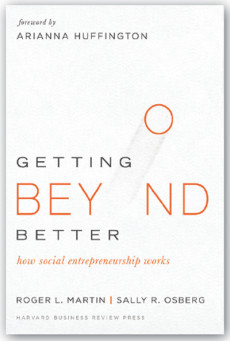
Getting Beyond Better: How Social Entrepreneurship Works
Roger L. Martin & Sally R. Osberg
248 pages, Harvard Business Review Press, 2015
In Getting Beyond Better, Roger L. Martin and Sally R. Osberg place the field of social entrepreneurship in historical context and present a “rough roadmap” for aspiring social entrepreneurs. To illustrate that roadmap, they use biographical vignettes of widely recognized social entrepreneurs, including Mohammed Yunus of Grameen Foundation and Paul Farmer of Partners in Health, as well as lesser-known figures such as Adalberto Veríssimo of Imazon and Ann Cotton of Camfed. For readers who are new to social entrepreneurship, this book provides a useful overview of the field and its protagonists.
I had hoped for something, well, better from Getting Beyond Better. Martin is a former dean of the Rotman School of Management at the University of Toronto; he also serves on the board of the Skoll Foundation. Osberg is president and CEO of the Skoll Foundation. Given their credentials, and given their Skoll connection in particular, I expected more than an overview. I was looking for rigorous analysis and “aha” moments that would elevate the field of social entrepreneurship. In the end, I didn’t find the ground-shaking insights that I craved. Still, I found the book to be an enjoyable read that contains several nuggets of wisdom.
In 2007, Martin and Osberg penned an article titled “Social Entrepreneurship: The Case for Definition” in Stanford Social Innovation Review. In Getting Beyond Better, they elaborate on the definition presented in that article. They contend that social entrepreneurs “take direct action and seek to transform the existing system,” with the goal of “forging a new stable equilibrium that unleashes new value for society, releases trapped potential, or alleviates suffering.” According to Martin and Osberg, successful social entrepreneurs tend to go through four stages of development: “understanding the world,” “envisioning a new future,” “building a model for change,” and “scaling the solution.” The bulk of the book consists of chapters that explore these stages using examples drawn from the ranks of Skoll Award recipients.
Disappointingly, Martin and Osberg seem to have reverse-engineered the steps that these award recipients took. They offer neither comparative data nor a broader analysis that would justify applying their conclusions only to social entrepreneurship. In fact, their four stages reflect broad trends in the social change field. By presenting those stages as though they were unique to social entrepreneurs, Martin and Osberg miss the opportunity to apply their insights to other change agents in the nonprofit, government, and private sectors.
In my view, Martin and Osberg set the bar for social entrepreneurship too high. Saying that social entrepreneurs must by definition be in the business of “ equilibrium change” runs the risk of excluding people who bring great ideas and tremendous energy to the work of social change. To see why this definition is problematic, consider some of the people profiled in the book.
Muhammad Yunus’s work as a microfinance pioneer had a modest start. While visiting a group of furniture makers in a Bangladeshi village, Yunus learned that they were trapped in a cycle of debt. “He reached into his own pocket to lend the women the money that they needed,” Martin and Osberg write. The women repaid that loan and continued to repay loans in subsequent situations. Only later, after learning from related experiments that other people had undertaken, did Yunus formulate a new “microlending” model and realize the power of that model to “shift the equilibrium” in his target market. Other social entrepreneurs discussed in the book—such as Farmer, who founded Partners in Health back in 1987—took decades to reach a point where they could achieve some kind of equilibrium change. It’s unlikely that these amazing entrepreneurs, in the early years of their ventures, could have articulated their models for “equilibrium change.” They started small, listened to people, adjusted their models, kept trying, and moved forward from there.
It’s a crucial point. Martin and Osberg, as representatives of the Skoll Foundation, have the power to set an agenda for this entire field. If their lofty definition of social entrepreneurship ends up creating a “club” that includes only scaled-up, equilibrium-changing models for social change, it will be a grave error. It takes vision to find, and courage to nurture, ideas that are promising but not yet proven. We don’t want to exclude early-stage innovators from the social entrepreneurship ecosystem merely because they have not yet attained—or even tried to attain—equilibrium change.
Despite these limitations, Getting Beyond Better offers insights that may help change makers and their funders to be more effective. Martin and Osberg, for example, outline three tensions that social entrepreneurs must manage in order to navigate the world that they wish to change: “abhorrence” versus “appreciation,” “apprenticeship” versus “expertise,” and “experimentation” versus “commitment.” In a chapter on building a model for social change, meanwhile, they explore important tactics related to financial models that can alter the status quo.
The world needs more would-be social entrepreneurs who will tackle the immense challenges of our time. I hope that this book will inspire them. But I also hope that they won’t treat the book as a checklist of requirements that they must meet in order to qualify as social entrepreneurs . Social entrepreneurship is a journey, not a destination, and the “roadmap” that Martin and Osberg present can support that journey.

